Scientific Views / The Bhaktivedanta Institute
The deeper scientists probe into the nature of perception, the farther away their subject recedes.
By Sadaputa Dasa
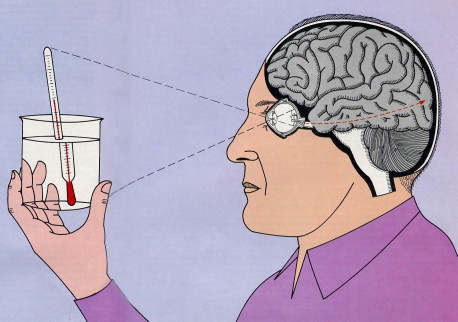
The idea that now dominates the life sciences is that life can be completely understood within the framework of chemistry and physics. Those who subscribe to this viewpoint say that we can explain all features of life—from the metabolic functioning of cells up to the mental phenomena of thinking, feeling, and willing-as the consequences of underlying chemical processes. With the spectacular successes achieved by modern molecular biology, this viewpoint has become so pervasive that, in the words of Nobel-prize-winning molecular biologist James Watson, “Complete certainty now exists among essentially all biochemists that the . . . characteristics of living organisms . . . will all be completely understood in terms of the coordinative interactions of small and large molecules. * (James Watson, Molecular Biology of the Gene, 2nd ed. (New York: W.A. Benjamin, 1970), p.67.)
Yet despite the popularity of this view, we can point to at least one feature of life—the phenomenon of conscious awareness—that is not amenable to a molecular explanation. The basic phenomenon of conscious awareness is the most immediate aspect of our experience, and it is automatically presupposed in all our sensations, feelings, and thought processes. Yet even though consciousness certainly exists and is of central importance to our lives, the current theoretical framework of biological and physical science cannot even refer to consciousness, much less explain it.
To see this, let us examine the process of conscious perception through the eyes of modern science. Our examination will take us through several levels of successively increasing detail, and at each level we will try to ascertain whether our scientific picture of reality sheds any light on the nature of consciousness.
First let us consider a man observing a physical object—in this case, a thermometer. Figures 1 and 2 depict the operation of the man’s sense of sight on the grossest biological level. The process of perception begins when light reflected from the thermometer is focused on the retina of the man’s eye, forming an inverted image. This light induces chemical changes in certain retinal cells, and these cells consequently stimulate adjacent nerve cells to transmit electrical impulses. These cells in turn stimulate activity in other nerve cells, and a systematic pattern of pulses is transmitted down the optic nerve. The image of the thermometer is now encoded in this pattern of pulses.
When these pulses reach the brain, a very complicated response occurs, involving many electrochemical actions and reactions. Although scientists at present do not know the details of this brain activity, they are nonetheless in substantial agreement about the basic phenomena involved. When the impulses streaming down the optic nerve reach the brain, they modify the overall pattern of chemical concentrations and electrical potentials maintained by the brain’s vast network of nerve cells. This pattern, scientists say, represents in coded form the specific content of the man’s thoughts and sensory impressions. As time passes, the physiochemical transformations of this pattern give rise to sequences of electrical impulses that emerge from the brain along various motor nerves, and these impulses in turn evoke corresponding sequences of muscular contractions. These organized contractions constitute the man’s gross external behavior, which may include spoken reports of his sensations, such as “I am seeing a thermometer.”
What and where Is Consciousness?
At this point in our investigation, we can understand how descriptions of this kind may, at least in principle, shed light on a person’s external behavioral responses to environmental stimuli. We can easily imagine constructing a machine involving photocells and electronic circuitry that would respond to a red light by playing a tape recording of the statement “I am seeing a red light.” On a more sophisticated level, we can visualize a computer that will analyze the images produced by a television camera and generate spoken statements identifying various objects. Thus although we are grossly ignorant of the actual physical transformations occurring in the brain, we can at least conceive of the possibility that these may correspond to processes of symbol manipulation analogous to those that take place in computers. We can therefore imagine that the man’s statement, “I am seeing a thermometer,” is generated by a computational process physically embodied in the electrochemical activity of the nerve cells in the brain.
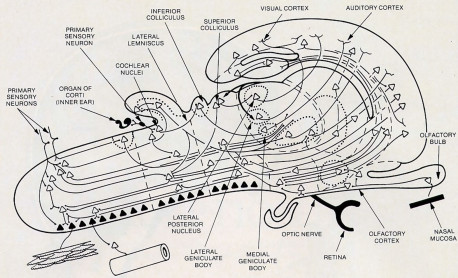
But all this tells us nothing about the man’s conscious perceptions. Our description of the image formed on the retina of the man’s eye says nothing about the conscious perception of that image, nor do scientists suppose that conscious perception takes place at this point. Likewise, the statements that light-sensitive cells in the retina have been stimulated and that sequences of nerve impulses have been induced convey nothing at all about the actual subjective experience of seeing the thermometer.
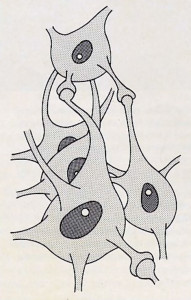
Many scientists feel that conscious perception must take place in the brain. Yet our description of the brain, even if elaborated in the greatest possible detail, would consist of nothing more than a list of statements about the electrochemical states of brain cells. Such statements might have some bearing on patterns of behavior, but they cannot explain consciousness, because they do not even refer to it.
At this point one may argue that since consciousness is subjective, we cannot use the word consciousness in scientific statements describing objective reality. One might point out that while we can observe a man’s behavior and measure the physical states of his brain, we could not possibly find any measurable evidence of his so-called consciousness. According to this idea, the man’s statements about his conscious perceptions are simply electrochemical phenomena that require physical explanation, but to say that consciousness exists in any real sense is meaningless.
Each of us can refute this argument by considering the matter in this way: The reality of my own conscious perceptions is certainly undeniable, and my understanding of all other aspects of reality depends on this basic fact. Thus I know by direct perception that consciousness exists in me, and it is also perfectly justifiable to suppose that other beings like me have similar conscious experiences. There is no need to embrace the futile and absurd viewpoint of solipsism, which holds that I am the only conscious being and that all others occupy a lesser status as mere automatons. Consciousness, therefore, exists as a feature of objective reality, and any scientific account of reality that fails to explain it is incomplete.

If consciousness exists but the level of biological description we have thus far considered does not refer to it, then how can we understand consciousness in terms of our existing scientific world view? The mere assertion that neural impulses “generate” consciousness does not constitute an explanation, for it offers no conception of any connection between impulses and our conscious perceptions. Our only recourse is to examine the structures and processes of the brain more closely, with the hope that a deeper understanding of their nature will reveal such a connection.
Going Deeper
Figure 3 presents a closer view of some of the neurons in the brain, and Figure 4 depicts the detailed structure of one of the synapses, or connecting links, between neurons. When we examine living cells closely, we find many intricate structures known as organelles. Just as we can describe the functions of the gross body in terms of the combined actions of its many component cells, so in principle we can describe the functions of the cells in terms of these subcellular components. Yet this does not help us in our attempt to understand consciousness, for it merely leads to a more complicated account of bodily behavior. As before, there is no reference to the conscious experience of seeing.
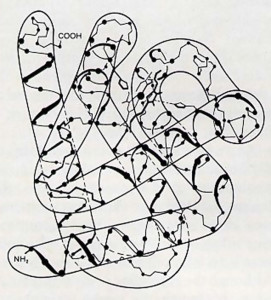
Let us go deeper. What is the essential nature of the cellular organelles? As we earlier pointed out, the nearly unanimous opinion of modern biochemists is that one can understand all biological structures as combinations of molecules, and all biological processes as the consequences of molecular interactions. Figure 5 depicts the three dimensional structure of a globular protein, one of the main kinds of complex molecules found in the body. Organic chemistry describes the structure of such molecules in terms of three dimensional arrangements of atoms, and molecular interactions in terms of the formation and dissolution of chemical bonds, or inter-atomic links.
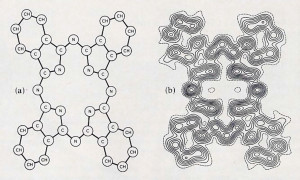
Biochemists have found that living cells contain many different kinds of extremely complex molecules. For example, the E. coli bacterium, one of the simplest unicellular organisms, is said to contain some two to three thousand different kinds of proteins, each of which consists of thou-sands of individual atoms. A complete molecular description of a single cell would therefore be enormously complex, and, in fact, scientists have not yet come close to providing such a description, even for the E. coli bacterium.
Yet however complex it might be, a description on this level would consist of nothing more than a long list of statements about the making and breaking of chemical bonds. Such a list could give us no greater insight into the nature of consciousness than any of the higher-order descriptions we have considered thus far. In fact, lists describing patterns of bonds and lists describing trains of nerve impulses are equivalent, in the sense that both say nothing about conscious experience.
Can Quantum Theory Explain Consciousness?
Can we find the insight we are seeking by taking a closer look at the atomic structure of molecules? In Figure 6 we see a diagram representing the spatial distribution of electrons within an organic molecule. Those who subscribe to the modern scientific world view claim that we can completely understand atoms and molecules in terms of the interactions of subatomic particles such as protons, neutrons, and electrons.
The branch of science that deals with these interactions is known as quantum mechanics, and it describes subatomic phenomena in terms of mathematical equations, such as the one depicted in Figure 7(a). Although pictures such as Figure 7(b) can partially express some features of these equations, they are essentially impossible to represent in three-dimensional form. We might wonder, therefore, whether some deep insight into the abstract mysteries of these fundamental physical equations might finally enable us to grasp the nature of consciousness.
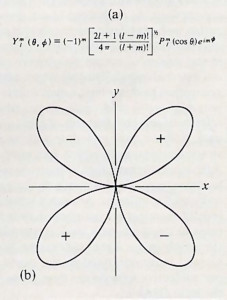
Unfortunately, however, this hope must meet with disappointment. If we study the essential nature of these mathematical equations, we find that they amount to nothing more than codified rules for the manipulation of symbols. Such symbols, in turn, are simply marks drawn from an arbitrary finite alphabet. They may be represented either by the internal states of an electronic computer or by marks on a piece of paper.
Thus Figure 8 gives us a glimpse of the ultimate appearance of a fundamental quantum mechanical description of nature when reduced to its elemental constituent terms. In this figure the alphabet of marks consists of 0, 1, 2, . . ., 9, A, B, C, . . .,F, and the rules for their manipulation are expressed in terms of the internal language of a particular computer. These rules simply describe certain ways of rearranging patterns of marks to create new patterns. Finally, in Figure 9, we reach the end of our investigation of the scientific world view. Here we find both patterns of marks and the rules for their manipulation encoded as strings of ones and zeroes.
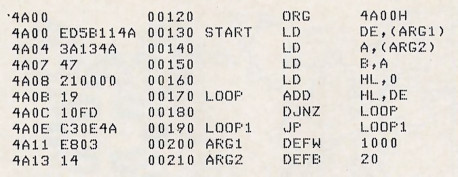
At this point we meet with final frustration in our effort to understand consciousness in terms of modern scientific conceptions. At each stage of our investigation we have been confronted with a set of symbols that refer to repeating patterns in the stream of events we observe with our external senses. Thus we began our investigation by describing a man with symbols like retina and optic nerve, which refer to observable features of gross anatomy. Now we have ended up with an abstract description in which our symbols refer to mathematical constructs, or even to elementary rules for manipulating arbitrary marks on paper. At each successive level of examination, our symbols failed to refer to consciousness, and, if anything, the symbols on each successive level seemed more unrelated to the world of our subjective experience than those on the level above it.
An Extension of the Scientific Method
How, then, are we to understand consciousness? Although we know by direct perception that consciousness exists, we have seen that the methodology of modern science is inherently incapable of revealing anything about it. Does this mean that we have encountered an insurmountable barrier to our understanding of reality? The answer, in fact, is no. In our remaining space we will outline an extension of the scientific method that can give us a satisfying understanding of consciousness.
This extension, known as sanatana-dharma, is delineated in the Vedic literatures of India, such as Bhagavad-gita and Srimad-Bhagavatam. Since it has been known for a very long time, it is an extension of the modern scientific method only in the sense that it has a greater scope than this method and logically includes it. Historically speaking, we would have to say that the modern scientific method is a contraction of sanatana-dharma.
We can break down the subject matter of sanatana-dharma into the following basic categories: the Supreme Self, or paramatma; the individual self, or jivatma; the superior, or spiritual, energy; and the inferior, or material, energy. As with any science, sanatana-dharma consists of a body of theory supported by observations. But the methods of observation employed by sanatana-dharma enable it to deal directly with all four of these categories, whereas modern science is restricted entirely to the category of the material energy.
According to sanatana-dharma, the real self, or jivatma of each individual person is an entity distinct from the material elements that make up the physical body. The jivatma is equipped with senses inherently capable of perceiving the paramatma, other jivatmas, and both the superior and inferior energies. However, in the state of existence familiar to us, the jivatma is associated with a physical body and can perceive the world only through the material sensory apparatus of that body.
The situation of the embodied jivatma is like that of a pilot flying an airplane on instruments (Fig. 10). The pilot can obtain only a very limited picture of his surroundings from such devices as the radar screen and the altimeter, although he still has his normal senses and, in fact, uses them to observe these instruments. The embodied jivatma is similarly hampered. Since the sensory apparatus of the body is composed of matter, this apparatus can provide information only about configurations of material energy and their transformations. One can use this information to make indirect inferences about the other categories forming the subject matter of sanatana-dharma, but this information cannot directly reveal anything about them. Since the modern scientific method relies solely on observation through the material senses, scientists have tended to ignore these higher categories or even to deny their very existence.

As we have seen, however, modern scientific theories cannot explain our direct perception of consciousness, and this failure is sufficient to show that such theories must necessarily be incomplete. According to sanatana-dharma, consciousness is an inherent feature of the jivatma. Although the embodied jivatma restricted to observing the world through material senses, all sensory information must eventually reach the senses of the jivatma itself. The self-referential aspect of consciousness, whereby the self is not merely aware but is aware that it is aware, arises because the true senses of the jivatma perceive their own operation. Thus the self is never completely limited to perceiving the material energy but also has some awareness of the spiritual category. At this point one may object that although modern science might not be able to explain consciousness, we gain nothing by asserting that a nonmaterial self exists and that consciousness is one of its characteristics. One may say that this simply amounts to assigning a name to the mystery of consciousness-a name, in fact, that consists of nothing more than some marks on a piece of paper.
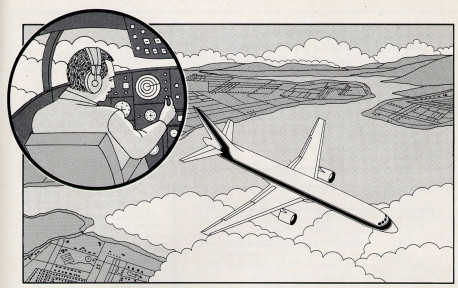
We reply to this objection by pointing out that sanatana-dharma provides methods whereby the consciousness of the individual can expand beyond the level of the material senses and come into direct contact with the paramatma and the superior, spiritual energy. Sanatana-dharma states that the Absolute Truth, the cause of all causes, is an eternal sentient personality who is the source of the innumerable jivatmas, or individual selves. These selves are also eternal persons, and though quantitatively minute and permanently individual, they are of the same qualitative nature as the unlimited Supreme Person. Thus each individual jivatma has a natural, constitutional relationship with the Supreme.
This relationship is one of loving personal reciprocation between the individual jivatma and the paramatma. Since personal reciprocation requires the use of senses, such a relationship can be experienced only if it is possible for the individual person to engage in active sensory perception on a level completely transcendental to the realm of matter. The purpose of the practical methodology of sanatana-dharma is to enable the embodied individual to attain to this level of sensory activity and reawaken his dormant relationship with the Supreme Person.
One method of doing this is by chanting the names of the Supreme Person. Since the Absolute Truth is personal, He has innumerable names, such as Krsna, Rama, and Govinda, and since He is absolute, these names are nondifferent from Him. By chanting these names, the jivatma comes into direct contact with the Supreme Person, and thus the jivatma gradually awakens to his natural relationship with the Supreme.
Here we see an interesting contrast between the use of symbols in sanatana-dharma and in modern science. From the viewpoint of modern science, the names Krsna and Govinda could at most be patterns of marks that play some computational role in a theoretical system. To the scientist, the ultimate justification for the use of such symbols would lie in the correlations he might find between the results of these computations and some measurements involving the physical senses.
If we simply examine these names through our physical senses, this viewpoint seems valid. However, sanatana-dharma takes into account the full sensory capacity of the self. From the viewpoint of sanatana-dharma, the pattern of marks corresponding to the name Krsna. and the manipulation of those marks on paper are the least significant aspects of the name Krsna. On the level of spiritual perception, the name Krsna is identical with the Supreme Person Himself. Thus Krsna is not merely a symbol but a name with inherent, absolute meaning. Because of his natural relationship with the Supreme, the jivatma can directly appreciate absolute reality; he is not limited simply to manipulating insubstantial networks of symbols that reduce in the end to nothing but strings of ones and zeroes.
We conclude by observing that sanatana-dharma offers an explanation of consciousness that is satisfying in a very genuine sense. In science, we generally say that an explanation is satisfying if it leads to new insights and new, interesting realms to explore. As it stands, modern science cannot provide such an explanation of consciousness. In contrast, sanatana-dharma introduces us to a realm of experience that gives us a deep understanding of the absolute nature and meaning of our own conscious existence.
SADAPUTA DASA studied at the State University of New York and Syracuse University and later received a National Science Fellowship. He went on to complete his Ph.D. in mathematics at Cornell, specializing in probability theory and statistical mechanics.

I am absolutely awed O_O ! Thanks for such a wonderful article. Hare Krishna !